

|
The original plan was to send out this issue of Dallying on Friday, because I was working all day Saturday, demonstrating seed planting and answering questions, see below. Didn’t happen and then we went to the hospital Saturday night so that we could be there at 3:19 AM on April Fool’s day to welcome our latest grandson as he arrived in the world. Even though he’s #10 it is still very exciting. Now back to our regularly scheduled program. 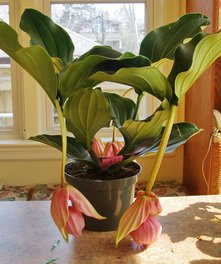 In our little corner of the world we, like most large urban centres, have a large spring garden show which we call Canada Blooms. Once again I had the privilege of speaking there on Vertical Vegetables. The crowds were noticeably smaller this year and that may be because the show was spread over ten days instead of its usual 5. I realize that I am old and jaded and hard to impress but there was not a very big ‘WoW’ factor in most of the displays. There was a wonderful large circle of roses in full bloom but for an interested gardener few if any of them were identified. Makes it hard to go and buy the one you liked. One of the most interesting booths was a group of growers that were introducing new plants. Medinilla magnifica is a tropical, native to the Phillippines, and the folks at Northend Gardens have spent considerable time developing this wild epiphyte into a marketable pot plant. It will bloom for 3 - 4 months and then for real gardeners there will be the challenge of trying to get it to rebloom.
In our little corner of the world we, like most large urban centres, have a large spring garden show which we call Canada Blooms. Once again I had the privilege of speaking there on Vertical Vegetables. The crowds were noticeably smaller this year and that may be because the show was spread over ten days instead of its usual 5. I realize that I am old and jaded and hard to impress but there was not a very big ‘WoW’ factor in most of the displays. There was a wonderful large circle of roses in full bloom but for an interested gardener few if any of them were identified. Makes it hard to go and buy the one you liked. One of the most interesting booths was a group of growers that were introducing new plants. Medinilla magnifica is a tropical, native to the Phillippines, and the folks at Northend Gardens have spent considerable time developing this wild epiphyte into a marketable pot plant. It will bloom for 3 - 4 months and then for real gardeners there will be the challenge of trying to get it to rebloom.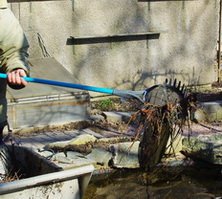 I took advantage of one of our unseasonably warm days and went after all of that algae that was thriving in the middle pond. It turned into a pond day. The bubblers were removed and the pump and its rather large inlet filter thingee were hauled out of the pond and cleaned. Plants that had become too big were lifted out. Removing some of them that had grown significant roots into the goo at the bottom of the pond was a bit of a challenge. One of the reasons that I don’t even try to keep my ponds crystal clear and sterile is the much greater growth I get from my Lilies etc. when they are allowed to root freely into that goo, rather than being restricted by pots. Simulating what happens in nature is often a good gardening technique. The fish produce nutrients and the plants recycle it into colourful flowers. It’s always a great refresher course in physics, when a pot that moves easily to the surface of the water becomes a very heavy weight once the flotation is removed as you lift it from the pond. I dredge the bottom of the ponds with a neat tool called a Pond Shark, that helps pick up the loose twigs, sticks and walnuts and the worst of the goo. Most of this, minus the walnuts, makes excellent compost.Return the pump, turn it on and listen again to the delightful sound of the waterfall.
I took advantage of one of our unseasonably warm days and went after all of that algae that was thriving in the middle pond. It turned into a pond day. The bubblers were removed and the pump and its rather large inlet filter thingee were hauled out of the pond and cleaned. Plants that had become too big were lifted out. Removing some of them that had grown significant roots into the goo at the bottom of the pond was a bit of a challenge. One of the reasons that I don’t even try to keep my ponds crystal clear and sterile is the much greater growth I get from my Lilies etc. when they are allowed to root freely into that goo, rather than being restricted by pots. Simulating what happens in nature is often a good gardening technique. The fish produce nutrients and the plants recycle it into colourful flowers. It’s always a great refresher course in physics, when a pot that moves easily to the surface of the water becomes a very heavy weight once the flotation is removed as you lift it from the pond. I dredge the bottom of the ponds with a neat tool called a Pond Shark, that helps pick up the loose twigs, sticks and walnuts and the worst of the goo. Most of this, minus the walnuts, makes excellent compost.Return the pump, turn it on and listen again to the delightful sound of the waterfall.  Tomorrow I’m planning to start more varieties of seeds than I have ever done at one time before. I’m in the local shopping mall answering questions and doing demonstrations all day. By the end of the day I will have planted many varieties of seeds and probably become hoarse from answering vegetable gardening questions all day. The event is hosted by the City and is promoting a variety of sustainable practices including vegetable gardening. Should be interesting but exhausting.
Tomorrow I’m planning to start more varieties of seeds than I have ever done at one time before. I’m in the local shopping mall answering questions and doing demonstrations all day. By the end of the day I will have planted many varieties of seeds and probably become hoarse from answering vegetable gardening questions all day. The event is hosted by the City and is promoting a variety of sustainable practices including vegetable gardening. Should be interesting but exhausting. 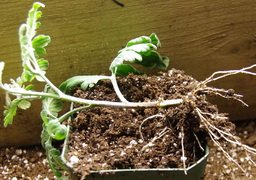 Something that I have always wanted to do, is to try and grow some exhibition Chrysanthemums. Those amazing plants that you see at garden shows in the fall with one giant flower atop a single tall stem. Last fall I was given both a yellow and a white one that were nearing the end of their blooming time. The friend who gave them to me wondered why I would take a couple of pots of almost finished plants. The stalks were cut down to within a few leaves of the ground and they were put under my lights so that the 16 hours of light would return them to a vegetative growing phase. They did and then a couple of weeks ago I was able to take several cuttings from the new growth that had emerged from the soil. Those cuttings will soon be potted up and I will start the summer long process of pruning and disbudding them in the hopes of having a nice crop of exhibition sized blooms this autumn. Gardening is always full of new and interesting things to try.
Something that I have always wanted to do, is to try and grow some exhibition Chrysanthemums. Those amazing plants that you see at garden shows in the fall with one giant flower atop a single tall stem. Last fall I was given both a yellow and a white one that were nearing the end of their blooming time. The friend who gave them to me wondered why I would take a couple of pots of almost finished plants. The stalks were cut down to within a few leaves of the ground and they were put under my lights so that the 16 hours of light would return them to a vegetative growing phase. They did and then a couple of weeks ago I was able to take several cuttings from the new growth that had emerged from the soil. Those cuttings will soon be potted up and I will start the summer long process of pruning and disbudding them in the hopes of having a nice crop of exhibition sized blooms this autumn. Gardening is always full of new and interesting things to try.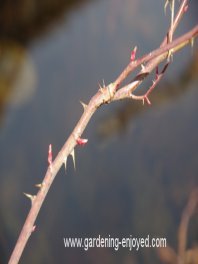 The mild winter has produced both some good and bad effects. The ground water recharge was limited and that may become a problem fairly early in the summer. On the other hand, all of my Roses are producing buds right up to the top of the old canes. There was minimal if any winter kill on those exposed Rose canes. This leaves us with a bit of a dilemma. We can let all of those buds develop and produce very much larger Rose bushes than we have ever had or we can cut them back to a few buds as we have always done. Conventional wisdom says to cut them back to three or four buds on the strongest three or four canes. That should produce strong sturdy bushes that will yield a good crop of blooms. Letting everything grow as nature allows it to may produce some interesting results. Typically the adventurous gardener in me will make sure that at least a couple of plants will be allowed to grow unpruned, just to observe what happens. I will prune most of them according to the tried and true rules and will keep all of you posted on the various outcomes.
The mild winter has produced both some good and bad effects. The ground water recharge was limited and that may become a problem fairly early in the summer. On the other hand, all of my Roses are producing buds right up to the top of the old canes. There was minimal if any winter kill on those exposed Rose canes. This leaves us with a bit of a dilemma. We can let all of those buds develop and produce very much larger Rose bushes than we have ever had or we can cut them back to a few buds as we have always done. Conventional wisdom says to cut them back to three or four buds on the strongest three or four canes. That should produce strong sturdy bushes that will yield a good crop of blooms. Letting everything grow as nature allows it to may produce some interesting results. Typically the adventurous gardener in me will make sure that at least a couple of plants will be allowed to grow unpruned, just to observe what happens. I will prune most of them according to the tried and true rules and will keep all of you posted on the various outcomes.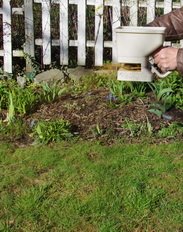 Despite my entreaties to replace all of your front lawns with sweeping curved beds of carrot tops and colourful lettuce, some of you will no doubt persist in trying to grow a patch of thick dark green turf grass. Now is the time to start that process. Rake off all of the winter debris and then rake again a bit more vigorously to remove all of the dead leaves and stems that we call thatch. This accumulates near the soil and starts to form a slightly solid mass that eventually can inhibit the ready passage of water and fertilizer to the soil underneath. The little grass plants can only absorb those essentials from the soil. At this time of year you want the leaves to grow rapidly and develop a dark green colour. That requires a fertilizer high in nitrogen, (that’s the first of the X X X three numbers on any fertilizer bag,) and some of that should be in a slow release form so that the grass plants get fed over a few weeks. Be lazy and only water your lawn once a week but give it at least an inch (2.5cm) of water when you do so. This will guarantee that the water penetrates about eight inches (20cm) into the soil, encouraging the grass to develop a deep healthy root system. Now if you are a real fanatic about your lawn, you keep a rain gauge in it and you add enough water each week to make up what the rainfall failed to provide.
Despite my entreaties to replace all of your front lawns with sweeping curved beds of carrot tops and colourful lettuce, some of you will no doubt persist in trying to grow a patch of thick dark green turf grass. Now is the time to start that process. Rake off all of the winter debris and then rake again a bit more vigorously to remove all of the dead leaves and stems that we call thatch. This accumulates near the soil and starts to form a slightly solid mass that eventually can inhibit the ready passage of water and fertilizer to the soil underneath. The little grass plants can only absorb those essentials from the soil. At this time of year you want the leaves to grow rapidly and develop a dark green colour. That requires a fertilizer high in nitrogen, (that’s the first of the X X X three numbers on any fertilizer bag,) and some of that should be in a slow release form so that the grass plants get fed over a few weeks. Be lazy and only water your lawn once a week but give it at least an inch (2.5cm) of water when you do so. This will guarantee that the water penetrates about eight inches (20cm) into the soil, encouraging the grass to develop a deep healthy root system. Now if you are a real fanatic about your lawn, you keep a rain gauge in it and you add enough water each week to make up what the rainfall failed to provide.Time to answer a few questions. If you have a gardening question just ‘reply’ to this newsletter and send me your query. I try to answer most of the questions and the ones that I answer here are those that I think will have the widest interest. You can also find the latest garden updates on the front page of gardening-enjoyed.com . Annette Asks? Is there any grass on the market that can withstand dog urine. I have a small yard and 2 female dogs, I have re-sodded twice in 3 years and seeded once. I have tried plenty of water . Is there anyway in keeping the grass alive. Ken Answers! No! Is the short answer. Too much nitrogen is your problem. Around the dead patch you will notice a ring of dark green growth where the Nitrogen is reduced to optimum levels. Follow your dogs around with a watering can and immediately saturate the spot they have over fertilized to dilute the quantity of Nitrogen. Not terribly practical but that’s about the only truly effective technique. Lottie Asks My front lawn is being taken over by "beautiful"violets, they spread so fast I see them taking over completely. last year I sprayed them with Weed B Gone. didn't do any good at all. I top dressed and over seeded in the fall but I am afraid that's not going to stop them. I know they are very hard to get rid off, but I am still hoping for a solution to the problem. What are your thoughts on it???? Ken Answers! Learning to really like Violets, only works when they are in bloom. Here in Ontario, any chemical that might work, is banned. If you live where 24D is still available it will have some effect on them. That leaves us with physically digging out each little clump and either composting them or potting them up to see if anybody at the local plant sale is foolish enough to buy them. Eleanor Asks? I had a male and female kiwi vine (3 years old). They were transplanted last year and this year one is dead. I’m not sure which is the male and which the female so how do I go about replacing the dead one? Ken Answers! It would take somebody with an intimate knowledge of the sex life of Kiwi vines to give you that answer before the remaining vines flower. Once that happens, then checking the blooms for anthers and pollen, indicating the male plant, should be relatively easy. Irene Asks? Purchased tomato stakes are usually not any higher than 60-70". Is it OK to keep the tomato plants pruned to this height without affecting the plant or is it better to use home made wooden stakes? On a daily or weekly basis, how much water (litres?) should each tomato plant receive? The leaves on our tomatoes always turn brown - is this over- or under-watering? Ken Answers? If your plants make it to 70" it should be fine to just prune the tops off or let them grow and flop. The chances of any fruit developing past that height before the end of the season, is pretty remote. The brown leaves later in the season are more likely the result of Early blight, a fungus disease, that gets to almost all Tomatoes eventually. You can spray to slow this down but it takes a lot of spraying and time to make a significant difference. Try to give your plants a total of one inch 2.5cm of water, rain + irrigation, every week and they should thrive. 111 Trent St. W. Whitby ON L1N1L9 |
